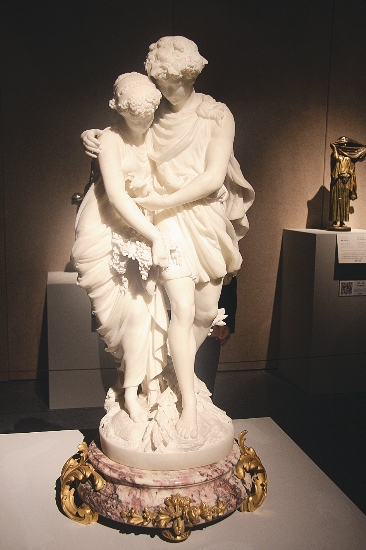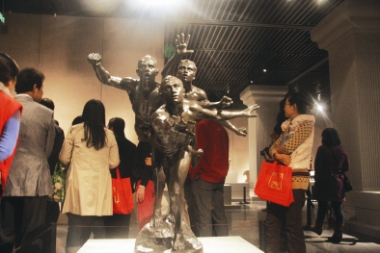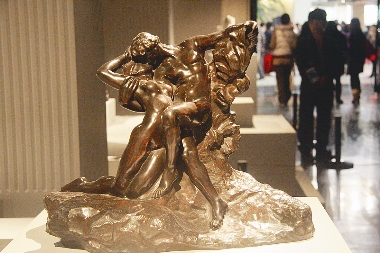



Helen Deng
THE sculpture “Eternal Spring” portrays two lovers passionately intertwined, wrapped in an everlasting embrace. As in holistic Greek sculpture, the two lovers are exaggerated in their passion for each other, thus forming a dynamic composition. The god-like male figure dominates the composition as he forcibly kisses the woman passionately; the woman, in turn, submits to his kiss and succumbs to her innermost desires.
It is Auguste Rodin’s (1840-1917) masterpiece, completed in 1884-85. One of a number of hymns to love that Rodin created after he completed “The Gates of Hell,” “Eternal Spring” is often associated with Rodin’s decade-long relationship with the sculptor Camille Claudel. The sculpture is full of awakening sensuality and implications of guilt or impending punishment are conspicuous by their absence. The neoclassical artwork, one of the master’s most popular pieces, is now on display at Shenzhen Museum, along with 78 representative artworks from 19th-20th century Europe, including three other pieces by Rodin: “I Am Beautiful,” “Minotaur,” and “Rodin’s Hand Holding a Torso, Type A.”
Shenzhen Museum is hosting “From the Academy to the Avant-garde” exhibition, featuring 79 classical sculptures and paintings from Mexican tycoon Juan Antonio Perez Simon’s personal collection. It is the first time for Shenzhen Museum to cooperate with Juan Antonio Perez Simon, one of the largest private art collectors outside Europe.
The exhibition offers a rare chance for locals to see famous European artworks from the 19th to 20th centuries, said Ye Yang, curator of Shenzhen Museum.
Exhibits include works by masters of various schools, such as “Hebe and the Eagle of Jupiter” by Francois Rude (1784-1855), and “Two Girls Beside the Stick Frame” by Alexander Max Koester (1864-1932). Paul Gauguin (1848-1903), Pierre Bonnard (1867-1947), and Alexander Archipenko (1887-1964) are also featured in the exhibition.
“It is a comprehensive collection of European art from the 19th-20th centuries,” said Ye, describing the exhibition as “one of the most important exhibitions in Shenzhen Museum’s 30-year history.”
The exhibition is divided into two parts: “Academic Art” and “Magnitude of Life.” The “Academic Art” part features sculptures and paintings by artists of the academic school, which flourished in Europe from the 17th to 19th centuries. This style of painting and sculpture was produced under the influence of various European academies.
Despite its supreme status between the 14th and 18th centuries, with the onset of the 19th century and the advent of modernism, academic art started to face a backlash and was criticized as “conservative, resisting any change or innovation”.
Zhang Gan, a professor at the Fine Art Institute of Qinghua University, said the exhibition was a chance for Chinese art fans to rediscover the unappreciated style of academic art.
According to him, this is the first time not only that academic paintings and sculptures have visited China on such a big scale, for many of them, it is the first time they can be appreciated so closely by Chinese art aficionados.
“Magnitude of Life” features works of more avant-garde artists. They abandoned the mythological and historical subject matter, the moralistic tone and highly supplicated style of academic art. Instead, they adopted subjects that are more closely related to people’s lives and expanded their vision to the real world. This part shows the artistic scene in Europe between the mid-19th century and early 20th century, with a series of vital works in various styles.
The exhibition was initiated in Beijing at the Beijing World Art Museum in September. It will move to Chongqing, Zhejiang, Hubei and Henan after being shown in Shenzhen.
This is the second time the art collector Perez Simon, collaborating with Beijing’s World Art Museum, has shared some of his best pieces with Chinese art fans on a grand scale.
|

